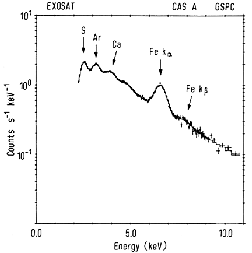|
|

X-ray Spectroscopy of Young SNR
Almost all the elements in your body and on the Earth except for Hydrogen and
Helium come from stars.
Some are generated by stars by nuclear fusion,
releasing the light that makes them shine in the process. Other, heavier
elements are created in the powerful throes of an exploding star, or
supernova explosion and hurled into space. When a star explodes, it
releases a tremendous amount of energy and can shine more brightly than an
entire galaxy.
Supernova explosions come in two different types, depending on the mass
of the stars that exploded. Type II SNe are the result of the
gravitational collapse of massive stars. Type I SNe arise from runaway
nuclear fusion on the surface of a white dwarf in a binary orbit.
The explosive force blasts the stellar material out into space.
The expanding material, and the gas it sweeps up as it expands, is
called a supernova remnant(SNR). A SNR is composed of stellar
material and interstellar material (ISM), heated to millions of degrees by the
shock of the supernova explosion. As the remnant expands, the stellar
material and the ISM mix. Eventually the remnant will disappear,
dispersing into space, enriching the ISM with heavier elements such as
carbon and oxygen (and heavier, up to and beyond iron). All of the
naturally occurring heavy elements we observe were distributed by SNes
and many heavy elements are only created in the extreme conditions of a
supernova explosion.
Most supernovae occurred hundreds or even thousands of years ago, so we
could not have observed the stars that exploded to form them. However,
by looking carefully at the supernova remnant, we can get many clues about
what the stars were made of and how they evolved.
Tools of the Trade
|
One of the most direct and most useful tools for learning about what a
star is made of is its spectrum (http://heasarc.gsfc.nasa.gov/docs/objects/snrs/puppisa_spectra.html). A spectrum is a measure of the light received as a
function of the light's wavelength, or energy. Gas that is very hot emits
radiation in a range of wavelengths. The hotter the gas, the higher energy the
thermal emission.
Gas heated to millions of degrees by the passing of a powerful
SNR shock emits strongly in the X-rays. What is particularly useful is
the fact that a hot gas emits in narrow energy bands or lines at very
particular energies depending on what gas it is. Looking at a spectrum
and identifying the lines in the spectrum allows us to identify elements
that are present in the emitting gas. For a young SNR which has not yet
swept up much of the gas of space around it, the composition of the
progenitor star shows up very strongly in its spectrum.
|

Spectrum of the supernova remnant Cas A showing prominent lines (http://heasarc.gsfc.nasa.gov/docs/objects/snrs/casa_spectra.html) |
Things We Can Learn About Stars from SNR
Astronomers are able to use SNR spectra to get all kinds of information
about the stars that exploded long ago and made the remnant. By looking
at the narrow lines and comparing to the lines of known elements we can
begin to figure out what the star was made of. By using the line
strengths of different lines, it is possible to estimate properties
such as temperature and pressure and density in the gas, as well as how
much the layers of gas in the star are mixed. We can compare the
observed values to stellar models to learn what kind of star the
progenitor was.
Do you want to know more?
Thank you to Una Hwang for contributing to this article.
|
